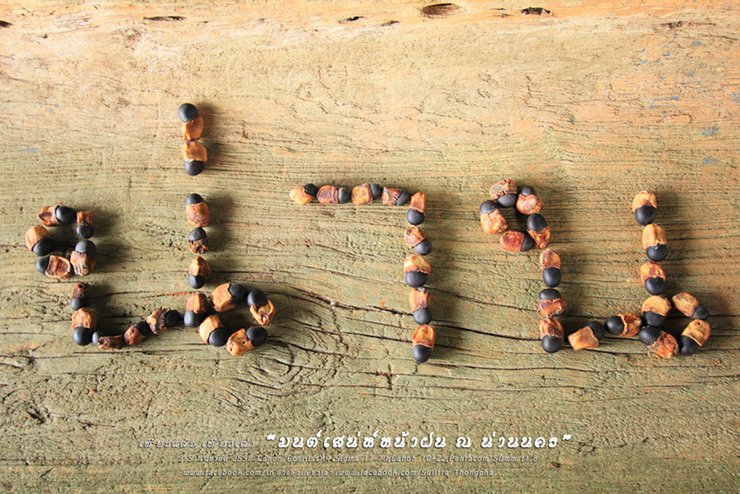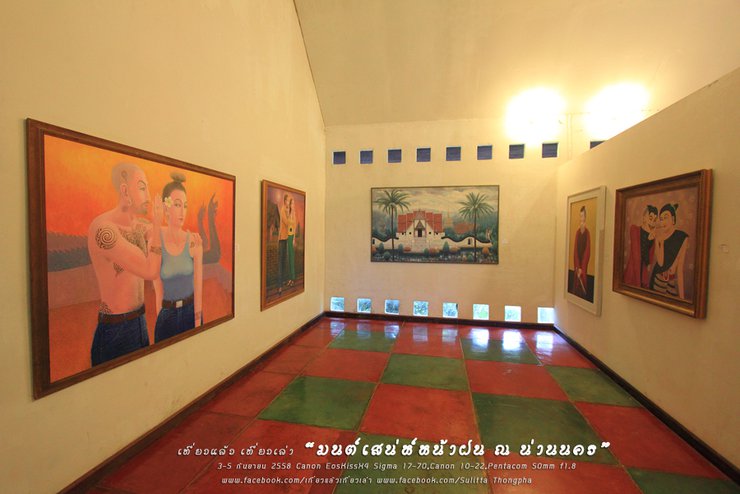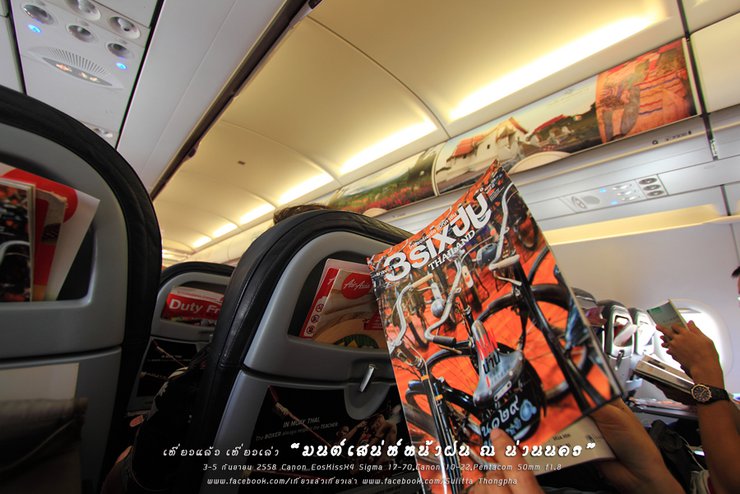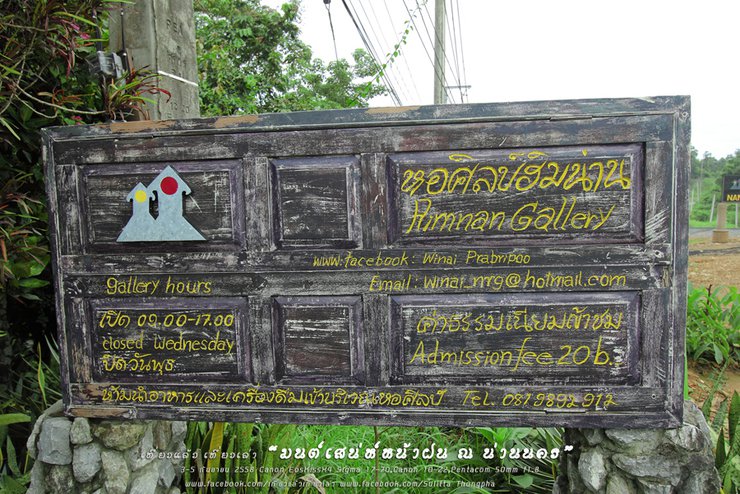

Hello, this is my first post. I apologize for any mistakes.
This is my second time visiting Nan Province. I fell in love with it the first time I came here at the end of 2013. Back then, I didn't do much research before my trip. I didn't know much about the famous tourist attractions in each district, and there were no flights to Nan yet. So I flew to Phitsanulok and rented a car to drive to Nan. I visited Khun Sathan National Park, camped at Doi Samer Dao for one night, and spent another night visiting temples, eating, and exploring the city. Then I went down to Phrae to visit my sister and stayed for one night before flying back to Bangkok from Phitsanulok. From that day on, I knew I wanted to come back to Nan.
On September 3-5, 2015, I finally got the chance to visit Nan again. AirAsia was having a promotion to celebrate three new routes: Roi Et, Nan, and starting at 333 baht per trip. I booked my flight early in the year and was lucky enough to get a seat on the plane painted with the Suphannahong boat design, which was part of the "Amazing Thailand Tourism Year" campaign in collaboration with the Tourism Authority of Thailand (TAT). It was beautiful and unique. Inside the cabin, there were advertisements for various tourist attractions in the 12 must-visit cities, and of course, "Nan" was one of them.

Traveling to Nan is quite convenient, with options for both buses and airplanes.
Travel by plane >>
- Nok Air operates 4 flights per day from Don Mueang to Nan / Nan to Don Mueang
- AirAsia operates 2 flights per day from Don Mueang to Nan / Nan to Don Mueang
- Kan Air flies from Chiang Mai - Nan / Nan - Chiang Mai
Travel by bus >> As far as I know, there are Nakhonchai Air, Sombat Tour, and Bus Terminal 999 (I haven't used it yet, I might use it next time)
Travel by train >> Get off at Den Chai, Phrae Province, then take a bus to Nan.

Our first AirAsia flight departed at 10:25 AM and arrived in Nan at approximately 11:30 AM. Those who dislike rushing might appreciate not having to wake up too early. However, for those who need to travel to distant districts, enjoy riding motorcycles or taking public transportation, or have limited time, this might be a bit late. Buses might be another option.
We rented a car at the Avis airport. It was convenient and independent. If you want to travel comfortably, buying a car rental voucher at the TAT Tourism Festival will save you a lot of money. Avis should be the only leading car rental company at Nan Nakhon Airport (normally using Budget). We booked a 1.5 engine car and got a Vios. The car was new and usable, but there were some scratches around the car, which seemed to have gone through some experiences. We chose to rent with full insurance without liability, so we could travel with peace of mind.

In addition, there are local car rentals available, both self-drive and with a driver. There are several counters located close together. If you don't know how to drive or don't like to drive yourself, you can use the services of a local driver. The people of Nan are friendly and no one knows Nan better than they do. If you want to go to the city, there may be a bus passing by to drop off outbound passengers (40-60 baht) or you can use a TAXI (100 baht). The price is not expensive because the airport is very close to the city center. It only takes 5-10 minutes by car. You can also bring your bicycle and ride around the city comfortably. Alternatively, you can use a TAXI to take you to different places, districts, or provinces. If you are traveling with 2-3 people, the average cost is not expensive. It is convenient and fast, another option for you.
Rates below

Day 1
- Fai Chaw Khao Restaurant: This restaurant serves traditional northern Thai dishes, including khao soi and nam ngiao.
- Mae Sunyee's Khao Soi and Nam Ngiaw: This is another popular spot for northern Thai cuisine, specializing in khao soi and nam ngiao.
- Nan Riverside Art Gallery: This gallery showcases the work of local artists and provides a beautiful view of the Nan River.
- Tanong Homestay: This homestay offers a comfortable and authentic experience of northern Thai culture.
After picking up our car from the airport, we drove into town to buy some local clothes to wear tomorrow. We wanted to help spread the wealth and stimulate the economy a bit. We stopped for lunch at Nam Ngiew Khao Soi Mae Sunaree. The food looked like the picture and everything was delicious. Most importantly, it was cheap at 30-40 baht. Come and try it! They also sell fermented pork sausage, which is quite famous and not expensive. I bought some to take back to Bangkok. It was delicious and just the way I like it.

Directions: From the airport, head towards the city center via Wat Suan Taan intersection. Drive straight for a short distance and you will find the shop on your right-hand side, opposite the gas station. The shop sign is prominent and easy to spot.
Nam ngiao, Khao soi Mae Sunyee

We then continued on the Wang Tha Pha route (the route back through the airport) to travel to Pua District, where we would spend the night. This route passes the Nan Riverside Art Gallery, about 20 km from the city center. We arrived at the Nan Riverside Art Gallery, parked the car, and it started to rain. It's normal to have rain during the rainy season. It was cool and comfortable. We visited the art gallery and waited for the rain to stop before continuing our journey.

"Nann Riverside Art Gallery" was founded by Ajarn Winai Prabripoo, a famous artist from Nan. Inside the art gallery, there are exhibitions of art, paintings, sculptures, wood carvings, and contemporary art by artists from senior to young generations.

The second floor also displays line drawings by Her Royal Highness Princess Maha Chakri Sirindhorn.

The Nan Riverside Art Gallery is situated amidst the natural beauty of the Nan River, surrounded by mountains. This allows visitors to enjoy art while feeling relaxed and at ease.

The jackfruit seeds fell from the tree, my sister picked them up and arranged them into the word "Nan". It's a cool opening image.


Envy the little cat

The entrance fee to the art gallery is only 20 baht per person, which is used for the maintenance of the place. You will also receive a postcard as a souvenir. Even though we are not very familiar with art, we still feel that it is worth visiting the art gallery here. If you have 1-2 hours, please stop by and visit. There is a small cafe at the back with good coffee. You can recharge your energy before continuing your journey to Pua.

It was almost three o'clock in the afternoon when we left the art gallery. The rain was still falling lightly. We drove slowly because the road was slippery and some sections were under repair. Along the way, we passed the entrance to Wat Nong Bua, but we didn't stop because the visibility was poor due to the rain. If anyone has the opportunity to come this way, please stop by. There are murals in the style of Nan Province, similar to Wat Phumin. We headed to our accommodation for the night. From Nan city to Pua district is about 60-70 km, which takes about an hour. But we drove slowly and didn't rush. We stopped to take pictures of the beautiful scenery along the way. It was almost five o'clock in the evening when we arrived.
Permission to post a picture of the map of Pua District from the "This is Pua Town" page.
https://www.facebook.com/pua108
www.pua108.com

We headed to Pua for our accommodation tonight. We drove straight ahead through the Pua intersection, passing the Krungsi Bank, which is uniquely built entirely of wood. We couldn't resist taking a picture of it.
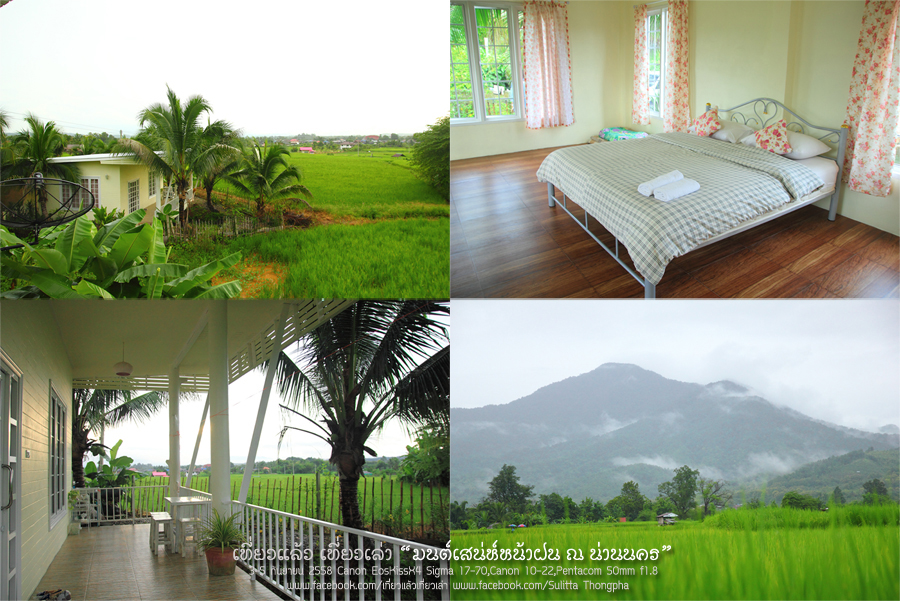
Drive straight ahead, passing the Mae Nam Khwang Bridge. Continue straight and look for a right-hand turn with a passenger pavilion and a sign for Ban San School. Turn right and continue straight, passing the market and the school. From here, we got confused and called the homestay, Tanong Homestay, which is currently being talked about. The owner of the homestay happened to be at the market nearby and rode a motorbike to take us to the accommodation. It's quite complicated to get there on your own, as the entrance is a small road that can only fit one car. On both sides of the entrance to the homestay are rice fields. We booked a new detached house with a very spacious room and a large bathroom. There is a patio and a small table in front of the house for dining, and there is also a place to wash dishes. If you come as a family, this room is perfect.

The rain was still drizzling as we went out to explore the 3-story house and walked to see the nearby rice fields. The atmosphere was very good even though it was raining. The homestay in the middle of the green rice field surrounded by mountains costs only a few hundred baht. It's very worthwhile. During our visit, the room rate was 500 baht/room/2 people for all rooms, excluding meals. There are a total of 5 rooms: 2 detached houses (old and new) and a 3-story building with 3 rooms. During the high season, the price may increase slightly.
Tanong Homestay


We didn't want to drive out to buy dinner again, so we ordered food from the accommodation. We didn't inform them in advance, so the food wasn't very full. Dinner was 100 baht per person, and breakfast was rice porridge with fried egg for 40 baht per person.

DAY 2 Wat Phukhao, Baan Huana Mushroom Farm, Lam Duan Weaving and Tai Lue Coffee Shop, Wat Phra That Khao Noi, Heuan Hom Restaurant, Pa Nim Dessert Shop, Nan Lanna Hotel
It rained heavily all night until morning. We waited until the rain started to subside before checking out of our accommodation at almost 9 am. The heavy rain caused the water in the river to rise and flow faster. Even though it rained heavily all night, the rice fields here were not flooded because they have a good water management system. There are small ditches beside the rice bunds to drain and divert water into canals and into natural water sources. My hometown also does rice farming, but it doesn't have a good water system like this.

After leaving our accommodation, we drove back along the same route, passing Kasikorn Bank (the easiest to spot). At the intersection, turn left and pass Somdet Phra Yuparach Pua Hospital (this route passes Wat Phukhet, Lamduan Pha Tok Coffee Tai Lue, and Ban Huana Mushroom Farm). Drive straight ahead and you will find a junction with a signpost for Wat Phukhet. Follow the sign and you will reach the temple. As Wat Phukhet is built on a hill, the highlight of this place is the 180-degree viewpoint overlooking the endless rice fields with a backdrop of rolling mountains. The view is absolutely stunning. Anyone can take beautiful photos at this viewpoint.

From the balcony of the Phuket Temple, in the middle of the rice fields, we can see the temple roof, which we later learned is the Lanna-style viharn of "Wat". There is a small community around the temple, making the scenery at this point even more beautiful.

The rain is still falling lightly, so the mountain scene behind is covered with fog, resulting in many beautiful pictures.
"Phuket Temple" is not only special for its stunning views, but it is also the first temple-stay hotel in Thailand. The four-story building has eight bedrooms, and the temple terrace where we took the photo is actually the rooftop of the hotel. Guests who stay at the temple to practice Dharma do not have to pay, but it depends on the generosity of the Buddhists. The Temple Stay was built in early 2012 and was inspired by South Korea. Since temples in South Korea are open for tourists to stay, Phuket Temple has adapted this concept into a Dharma hotel. This is a great idea that has helped increase the number of people visiting the temple to practice Dharma and learn about the way of life of the people in the community around the temple.
Phuket Temple

The name "Phuket" is not related to the province of Phuket. However, because it is located in Ban Ket and the area is a hill, it is named Wat Phuket.

The balcony has a fish food dispenser. You can make merit by putting money in the machine according to your faith. The PVC pipe here is for pouring fish food into the canal below. It's a great idea! Or, if you want, you can walk down the stairs and walk below.

After paying respects at the temple and admiring the mountains and rice fields, we continued our journey to the Baan Huana Mushroom Farm. Leaving the temple, we returned to the main road and continued straight ahead. We kept an eye out for the signs along the way. Before reaching the entrance to the Baan Huana Mushroom Farm, we passed the Lam Duan Weaving Shop and Tai Lue Coffee Shop. We decided to visit the mushroom farm first.
Baan Hua Nam Mushroom Farm

The view is beautiful. It is located on a hill with two detached houses offering 180-degree views. Inside, there are 3 adjoining rooms.

The large house is a restaurant and beverage shop. There is a way down to Wang Sila Lang, a strange and beautiful tourist attraction caused by a fault. Over time, the Goon River has eroded the mountain rock into a 300-400 meter long channel, making it an adventure spot in Pua. If you come during the hot season, March-April, it will be very beautiful. During the rainy season, there is a lot of water, which is not suitable for tourism. So we don't go.
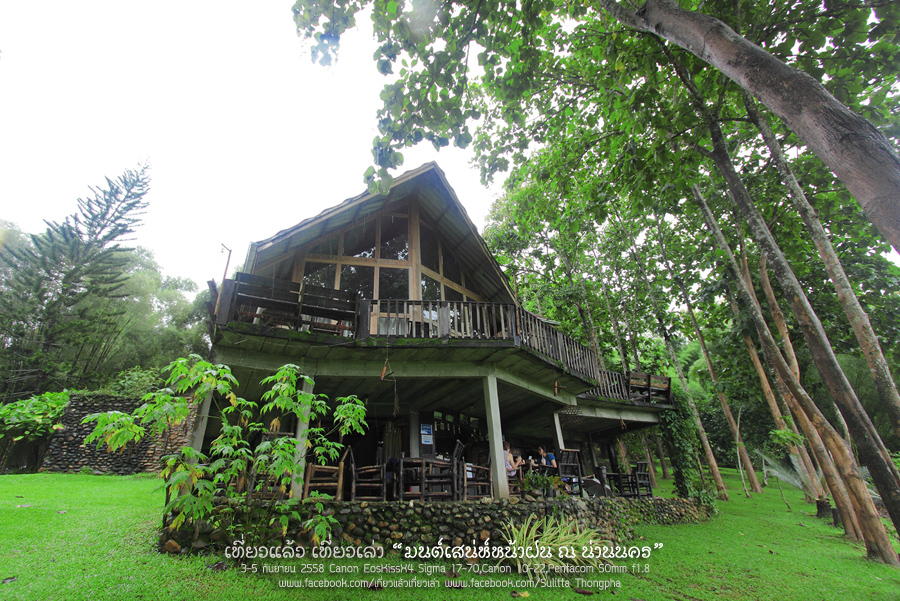
Since it is a mushroom farm, the restaurant has a wide variety of mushroom dishes to choose from. We ordered the mushroom salad and stir-fried mushrooms with oyster sauce. The taste was bland, perhaps to the liking of northern people, but many people said the mushroom pizza was delicious. We didn't try it. My sister drank hot cappuccino, while I drank avocado smoothie. The coffee was smooth and fragrant, and the avocado smoothie was delicious and sweet with honey. The cost of food and drinks was 280 baht.

It was past one in the afternoon and the rain was still drizzling. We left the mushroom farm and went back the same way. We stopped by the Tai Lue coffee shop. This place uses fresh coffee beans from Wang Tha Pha. We were still full from the mushroom farm, so we ordered an iced latte to drink. It tasted good and, most importantly, it was very cheap. The cup was also big, only 30 baht.
Lam Duan Weaving Shop, Tai Lue Coffee

Nestled amidst a picturesque rice paddy, this Tai Lue-style coffee shop boasts a serene ambiance. With rolling hills as its backdrop and a small irrigation canal meandering through the property, the owner's ingenious idea of installing a water wheel has become the establishment's iconic symbol. As the barista informed us, "If you haven't reached the water wheel, you haven't truly arrived at the cafe." Intrigued, we embarked on a journey across a classic bamboo bridge, eager to capture the perfect shot of the mesmerizing water wheel.


The Tai Lue Coffee Shop is built as a pavilion in the middle of a rice field. The coffee tables, which are usually found in shops, are replaced by individual pavilions connected by bridges, creating a unique and private experience for customers. The shop is close to nature and is perfect for relaxation. There is a small book corner where you can pick up a book and read while sipping your coffee or tea, or you can lie down and relax with a pillow. We love this place very much. It feels so relaxing that we could stay here all day.


Pua has many interesting tourist attractions. Due to limited time, we missed many places. But we will return to visit Pua again, a peaceful city with friendly people. There are old tools and equipment of the Tai Lue people to see.

We spent almost 2 hours playing, lying down, and taking pictures. This is probably the last place we will be in Pua. This evening we will return to stay in Nan city.


Before heading back, we stopped by "Lam Duan Woven Fabric Shop" to buy local clothes. It's right next to the Tai Lue coffee shop and they have the same owner. The woven fabrics here are also exported to Laos. The owner told us that the coffee shop isn't their main business, it's more of a place for customers to relax and wait. The husbands can sit and enjoy a cup of coffee while their wives shop for clothes. It's a great idea that pleases both the shoppers and those who are waiting.

The clothes here are very cheap, priced at 100-300 baht. We got a Karen-style dress, a skirt, and a shirt for only 700 baht. It's not expensive at all. Much cheaper than in the city. It helps distribute income to the community and stimulate the economy as usual.

Around four in the afternoon, it was time to say goodbye to Pua town. The rain had just stopped after falling all day. We headed back to the city, stopping to take some pictures of the view along the way. We arrived in the city at around five o'clock and drove up to Wat Phra That Khao Noi to pay our respects to the Buddha statue and enjoy the view of the city and the last light of the day.
Help the dog cross the road.

"Wat Phra That Khao Noi" is located on the top of Khao Noi mountain, about 240 meters above sea level. It is located in Mueang Nan district, not far from the city center. It is another important and ancient religious site in Nan province. It is assumed to be the same age as Phra That Chae Haeng. Because the temple is located on a high mountain, it is a viewpoint with beautiful views of Nan city. At the concrete courtyard, there is a large golden Buddha statue in the attitude of walking, "Phra Phuttha Maha Udom Mongkhon Nanaburi Si Mueang Nan", which was built to commemorate the auspicious occasion of His Majesty the King's 6th cycle birthday (72 years old) in 1999. It is an important landmark of Nan province. You can drive to the temple or walk up the 303 steps of the Naga stairs in front of the temple.



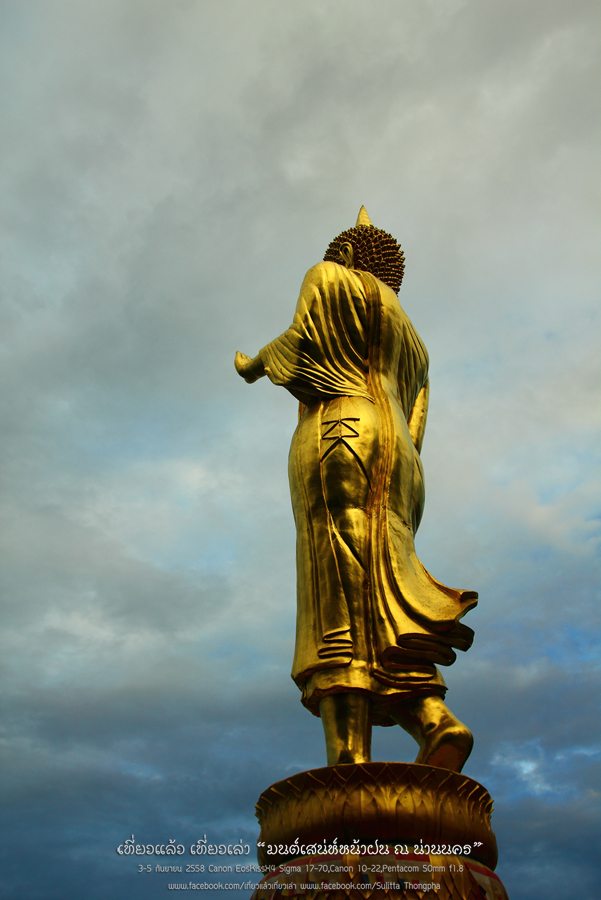
View of the city from the Buddha statue platform at Wat Phra That Khao Noi


We then checked in to our accommodation for the night, "Nan Lanna". The hotel is relatively new, with prices in the hundreds. It has 2 floors and 10 rooms, and is located in the heart of the city near Wat Hua Khuang. From here, you can walk or cycle to Wat Phumin, Wat Phra That Chang Kham, Nan National Museum, and the Tourist Information Center. If you come on a Saturday or Sunday, there is a walking street at Khwang Muang, which is very close to the accommodation.
Nan Lanna Hotel

The rooms are decorated in a modern Lanna style, spacious, clean and fully equipped. The room rates during the green season are as follows: Room for 2 people, double/single bed, 600 baht; Room for 3 people, 800 baht; Extra bed 200 baht/person. No breakfast is included, but tea, coffee and bread are available throughout the day. During the high season, the price is likely to increase. It is a hotel in the Huen Khuang Nan group, located just 200 meters from Huen Khuang Nan. Bicycles are available for rent at 80 baht/day.
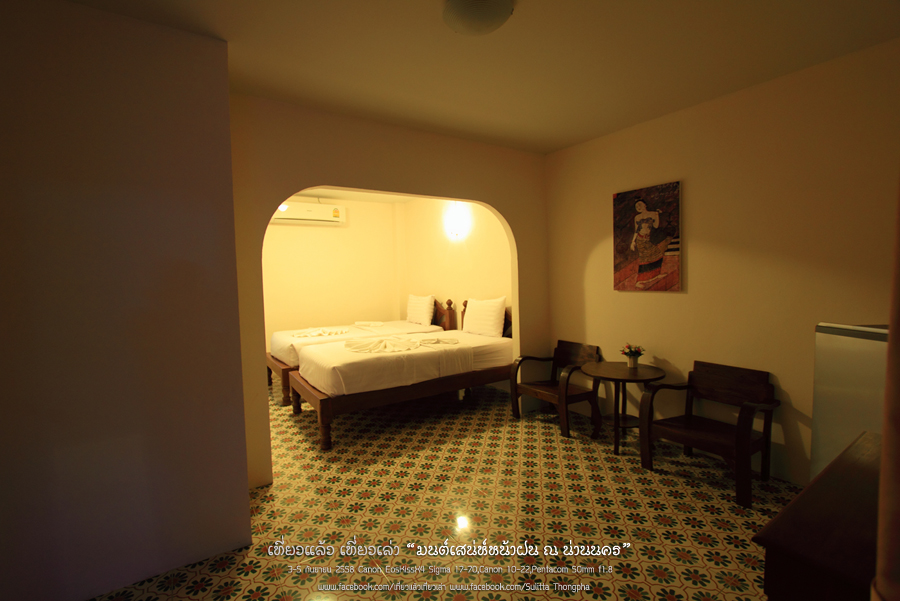
Favorite corner

It's dinner time. We weren't very hungry, so we ordered a single dish at the Heuan Hom restaurant: Khao Pad Nam Prik Num, Khao Kluk Kapi, and Moo Tod Makwaen (Makwaen is a famous spice from Nan). Everything was delicious, and the food was very affordable. The total cost was 250 baht.

Directions: From the traffic light intersection at Wat Phumin, go straight along the road past Wat Ming Mueang (the city pillar). The shop is opposite the 7-Eleven store (the brown 7-Eleven store blends in with the old town). Next to the 7-Eleven store, there is a Boon Sak tofu shop that sells many flavors of tofu. It's so popular that you need to take a queue number. It's delicious. Then we go to "Aun Nim's Dessert Shop". Drive straight ahead until you reach a traffic light intersection. On the opposite side on the right, you will see the golden Wat Sri Pan Ton. On the left hand side, you will see Aun Nim's Dessert Shop. You can ride a bicycle there, it's not far and it's fun. Nan is a bicycle city. This is Auntie Nim, the owner of the shop. If she smiled more, she would be very cute.
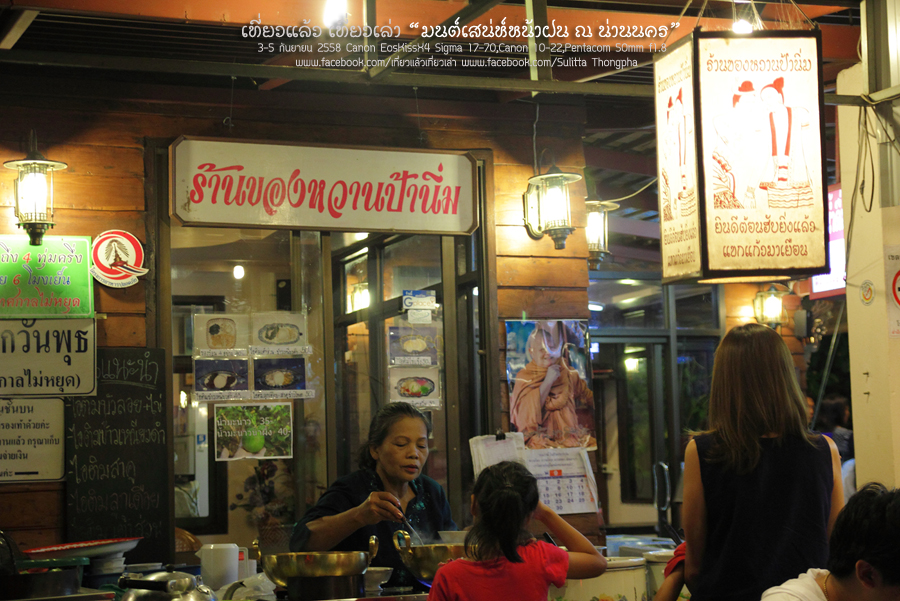
We ordered the Sweet Lotus Seed with Young Coconut and Ice Cream for 45 baht. The price was neither cheap nor expensive. The taste was okay, but not outstanding. I've had better before. The strange thing is that the ice cream made it taste better.

After a satisfying meal, we returned to our accommodation to rest and recharge for our final day of sightseeing.

DAY 3 Nan National Museum, Wat Phumin, Wat Phra That Chang Kham, Wat Hua Khuang, Wat Hua Wiang Tai, Wat Phra Non, Wat Ming Mueang City Pillar, Wat Montien, Wat Phra Phu, Wat Suan Tan, Coffee Sound, Baan Baan Nan Library, Chompoo Phuka Silverware Center, Teeo Rai Thiam Than, Khao Soi Ton Nam Restaurant, Khao Soi Mae Suni Restaurant
I woke up early today and slept soundly all night. I checked out at 7:30 am and drove to the tourist service center next to Phumin Temple to book a ticket for the first round of the Nan city tram. I was the first one there and no one else was around. I rushed over because it was Saturday and the tram was expected to fill up quickly. I asked someone nearby and they said it would open around 8:30 am, so I went for a walk around the area. When it was almost time, I went back and the tourist service center had just opened. I went straight to inquire about the tram and the staff told me that the first round was already full, booked by a tour group. I was a little disappointed because I had rushed over. The next round was around 10:30 am, and I couldn't book a ticket in advance because they said the ticket seller hadn't arrived yet. I didn't want to wait any longer, and I didn't know if it would be full again because of the tour group booking. So I decided to drive around myself. I think there should be a quota for both tour groups and walk-in visitors. It would be a good thing. When I explored on my own, no one was there to explain the history of the different places, and no one knows Nan better than the people of Nan. So I walked around on my own. There are important places nearby that are within walking distance of each other.

Complaining to the cat, the cat still ignores me ^^
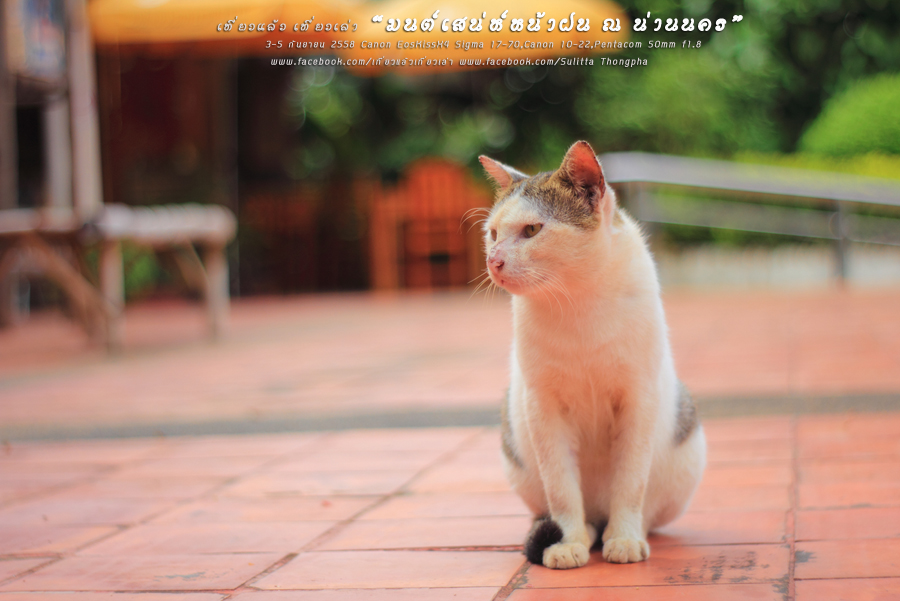
"Wat Phumin" is a unique temple with a four-sided structure. Inside, there are four principal Buddha images facing the four cardinal directions, each in the "Maravijaya" posture.
Phumin Temple




The Naga archway at the entrance to Wat Phumin. It is said that those who pass through the belly of the Naga will be lucky and return to Nan again.

There is a legend that if you go to pray to the Phra Chaturathit, try to observe the face of the Buddha in one of the four directions. There will be only one direction where the main Buddha statue has a more smiling face than the other three directions. Pray in that direction and your wish will be granted. I just read this on my way back from Nan. I didn't notice which door I entered, so I just prayed in that direction. ^^


The murals at Wat Phumin depict the story of "Kantakanthaka," a Jataka tale that teaches people to do good deeds. The artist has incorporated scenes of daily life in Nan province in the past. Painted in the late reign of King Rama IV, the murals' beautiful and unique patterns are a captivating charm for those who have the opportunity to see them.


The mural painting "Pu Man Ya Man" (Pu is used to refer to men, Ya is used to refer to women) was created by an artist named Nan Buaphan, a local painter of Tai Lue descent. It is recognized as a masterpiece and is the most prominent image of Wat Phumin. It depicts a Burmese couple whispering to each other and is famously known as the "Whisper of Love that Echoes Around the World." It has become a symbol of Nan Province, appearing in shops, hotels, resorts, restaurants, cafes, and various merchandise such as T-shirts, postcards, and even home decor items.


We then crossed the road to the opposite side of Wat Phumin. On the right-hand side, we saw "Wat Phra That Chang Kham". Inside the viharn is a bronze Buddha statue, Phra Phuttha Nantaburisi Sakyamuni.
Wat Phra That Chang Kham

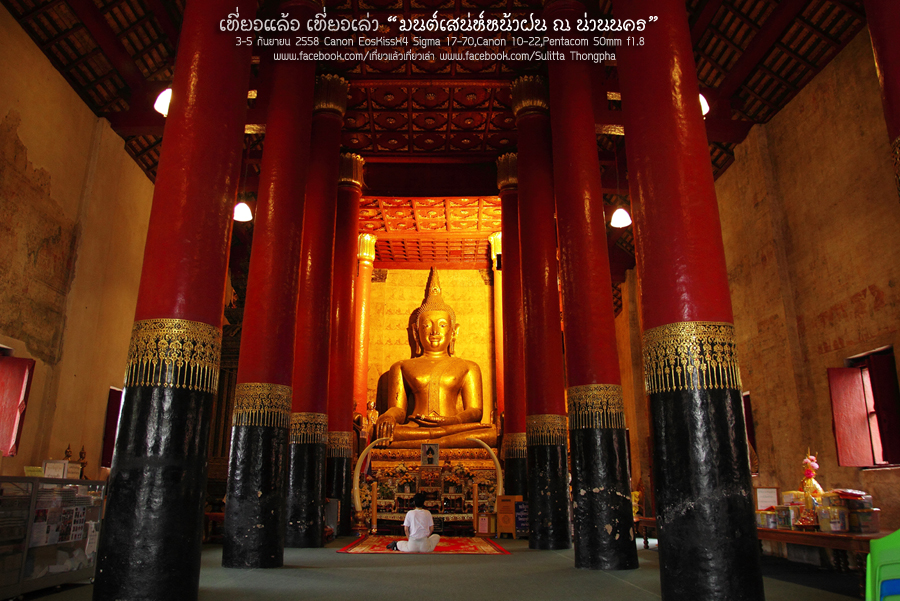
Behind the main hall is a stupa with a base made of bricks, shaped like elephants supporting the stupa. This is an example of Sukhothai art.

Crossing over to the left side is the "Nan National Museum". During our visit, it was closed for renovation, but it should be open soon. In front of the museum, there is a row of frangipani trees planted on both sides, forming a beautiful tree tunnel. It has become another symbol of Nan. Anyone who comes to visit Nan must come to take a photo at this spot as a souvenir.
Nan National Museum
If you have any other text you would like me to translate, please provide it and I will be happy to help.

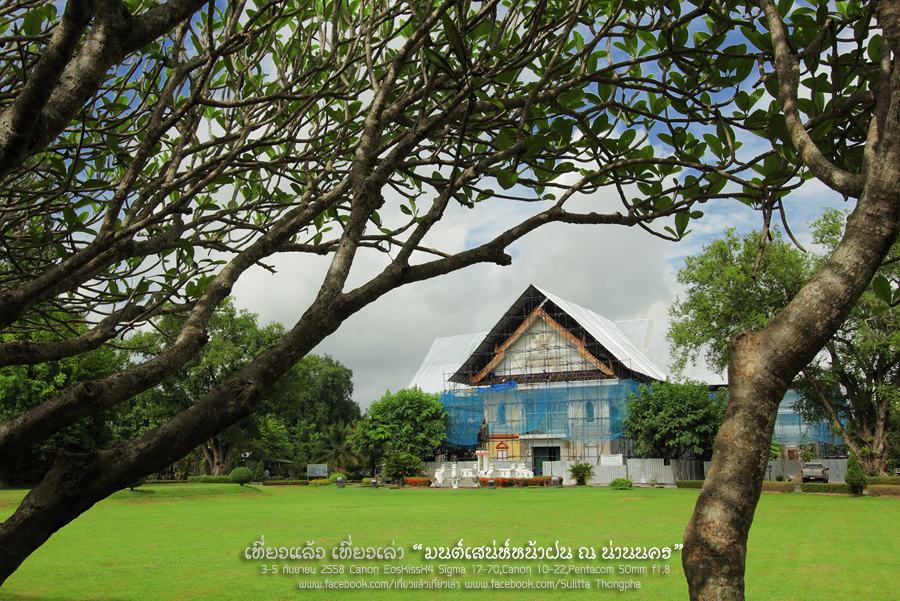
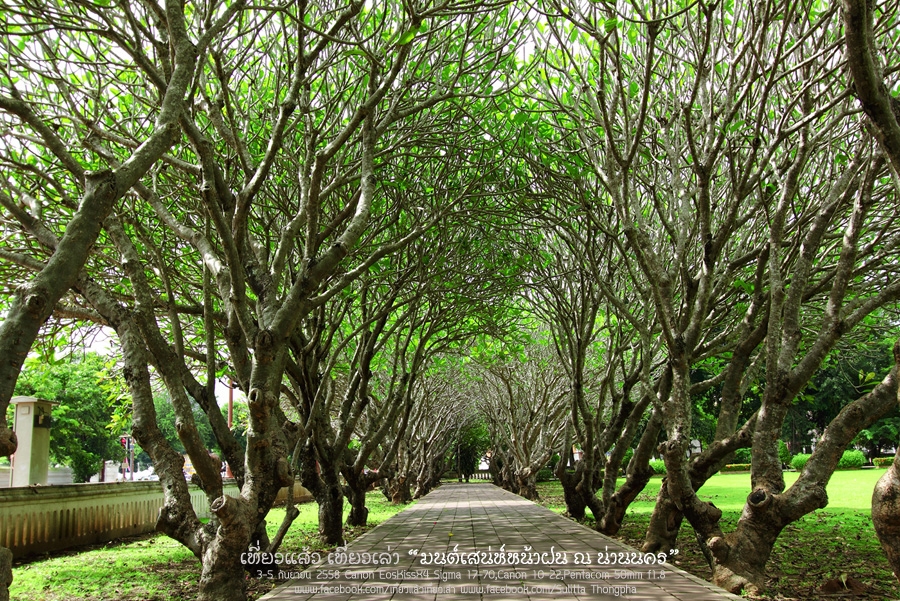
I'd like to post a picture of myself.

Adjacent to the Lilawadi Tunnel in the Nan National Museum is "Wat Noi," the smallest temple in Thailand. According to legend, King Suriyaphong Pharitdet, the 63rd ruler of Nan, reported the number of temples in Nan to King Chulalongkorn (Rama V). However, it turned out that he had counted one temple too many. Therefore, Wat Noi was built to compensate for the error.
Wat Noi

Next to the Nan National Museum is "Wat Hua Khuang". Inside the temple there is a Dharma Hall, which houses the Tripitaka and ancient scriptures.
Wat Hua Khwang


It was noon, and we drove to have lunch. While looking for a restaurant, we stopped by "Wat Hua Wiang Tai" to pay our respects.
Wat Hua Wiang Tai

And we arrived at the restaurant "Unparalleled Noodles". We ordered pork bone Tom Yum noodles and pork bone Tom Yum rice. The bowl is large and worth the price. The pork bone is large and has a lot of meat. The taste is delicious. My sister likes it, but I prefer it to be more sour and spicy. The lemon here is big and fragrant, but not as sour as the lime. This bowl is 50 baht.
Unparalleled Noodles


Across the street from the unbeatable noodle shop, there is a coffee shop and fusion restaurant called "Coffee Sound and U Dee Kin Dee". They are owned by the same owner. We had coffee and sat here for a while. The shop is cutely decorated and the coffee is delicious.
Coffee Sound



We then continued our trip to the "Baan Baan Nan Nan Library", which has books to read. It is a 2-story old wooden house. The lower floor is a stilt house with a small coffee shop. There is a corner for sipping coffee and reading books. We ordered iced tea to drink and lay down and sat on the upper floor. The atmosphere is comfortable, like being at home. The owner is kind. There is no entrance fee, but please support the drinks to generate income for the maintenance of the place.
A library in Nan province.




Next door is another wooden house that serves as a guest home. It has 4 lovely rooms for a few hundred baht each. The atmosphere is like sleeping at a relative's house. We sat in the library for over an hour.

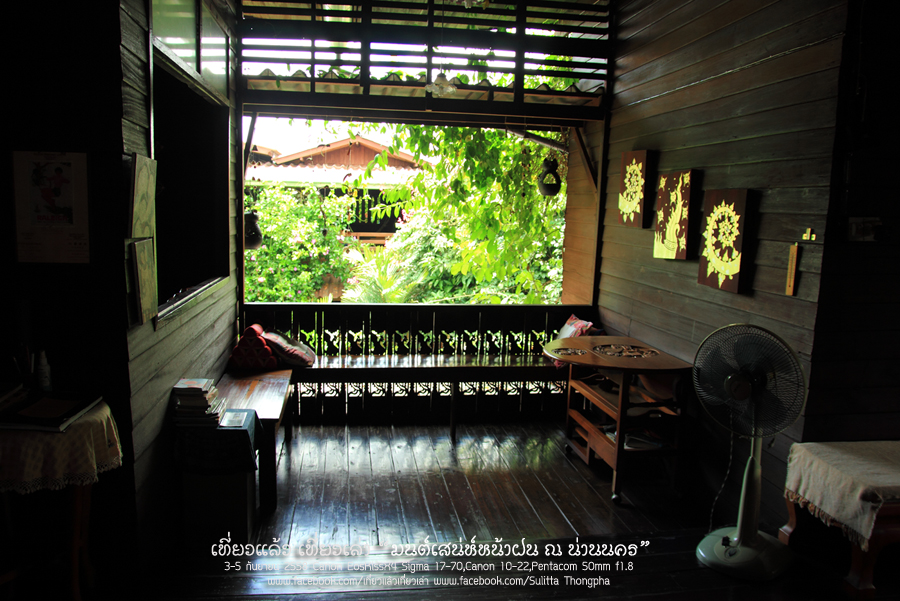
Near the cozy library in Nan, there is "Wat Montien". We paid our respects at the temple and had to park our car there because the library is located in a narrow alley where parking is not available.
Wat Montien

We then went to Wat Si Phan Ton, but I didn't take any pictures because there was a van parked in front of the church door, which made the picture not very nice. We also stopped by the silverware center, Chumphu Phu Kha, which is a little past Big C. There was a lot of silverware to choose from, and it was all very beautiful.
Pinka Phu Kha Silverware Center

After leaving the silverware center, we stopped by the Ton Nam Khao Soi restaurant, which is located next to the Seven Eleven opposite the Heuan Hom restaurant. It's very easy to find. We ordered the pork khao soi, but we didn't really like the taste. It was bland, but it was still edible. Maybe it's a taste that other people like.
Not far from the Khao Soi restaurant is "Wat Ming Mueang", home to the Nan City Pillar. The most striking feature is the exquisite white stucco pavilion with four faces, topped by a four-faced Brahma, which houses the City Pillar Shrine. Further inside is the temple's chapel, which is a stucco art by Chiang Saen craftsmen. Inside, there are murals depicting the legend of the history of Nan city.
Ming Muang Temple, City Pillar Shrine


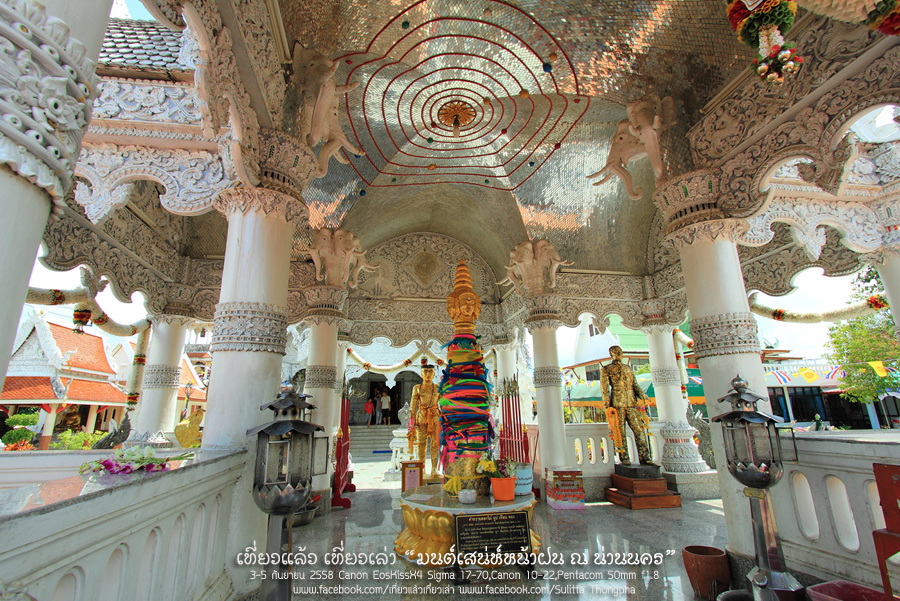


The painter is filling in the color.

There is a local educational music band at the pavilion. They are very cute. If you are interested in booking them for a performance, please contact them.

Not finished yet. I would like to continue reviewing tomorrow evening. Thank you for reading. Thank you, Mai Mai, for reading.
I will continue my review later in the evening. While we still had time, we stopped by "Wat Phra That Khao Noi", which is the oldest temple in Nan province. It may be a bit dilapidated, but if it is maintained and its beauty preserved, it will surely be a place of interest and remain a part of Nan province for a long time to come.
Phra Yai Temple

Back in the city "Wat Phra Phu" for a moment. It seems like there is an event at the temple.
Wat Phra Yai

And then it was time to return to the capital. We went back to eat at the Nam Ngiew Khao Soi Mae Suni restaurant again. I like this restaurant the most. It's delicious, affordable, and I bought some fermented pork sausage as a souvenir.
Before heading back to the airport, we made a stop at the last temple on our way, "Wat Suan Tal". This ancient temple is located in the city center of Nan, second only to Wat Phra That Chae Haeng in terms of age. Inside the main chapel, the principal Buddha image, "Phra Chao Thong Thip", a large bronze statue in the Mara-Vijaya posture, is truly magnificent. Currently, the interior of the chapel is undergoing renovations to enhance its beauty.
Wat Suan Taan



Behind the ordination hall is the stupa of Wat Suan Taan. Currently, it is undergoing restoration due to damage caused by the earthquake, which has partially damaged the structure.

It's time to go home. We filled up the rental car and returned it. Our AirAsia flight is at 4:45 p.m. Nan Airport is not very big, but everything is well-proportioned and cute. I really like the departure hall. The high ceiling is airy and spacious. I envy the people of this province. Everything is good, it's a very livable place.


Inside the airport, there are shops selling souvenirs, snacks, and local fabrics. The prices of some items may be slightly higher than outside due to the rental costs, but they are not expensive. Please support them!




Farewell, lovely Nan. I will visit you again.



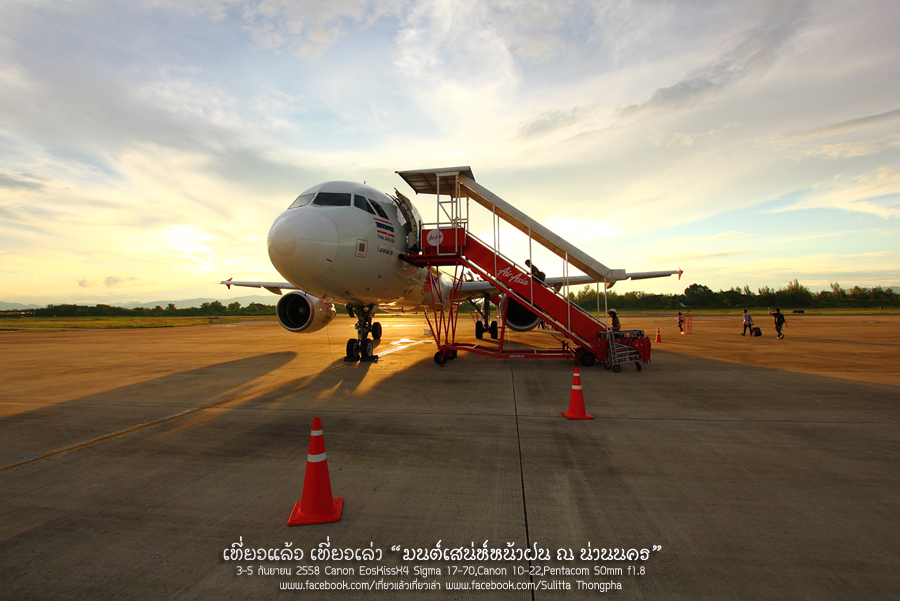
The total cost of the trip, including everything for 3 days and 2 nights, is approximately 4,000 baht per person.
"Nan," a small town that you wouldn't reach unintentionally, as it's a border town hidden amidst the mountains.
Having experienced it firsthand, I was so impressed that I had to find a way to return. Nan doesn't want tourists, but rather friends and relatives who come to visit their home. It's safe to say that it's our number one must-visit city.
Nan, a living old city. Policies and tourism trends have changed many communities in Thailand into tourist cities until there is almost no original identity left. But Nan still maintains that. A small, peaceful city, a simple way of life, a city of Buddhism, Lanna culture of the east. These are the true charm and value of Nan. I want it to be preserved. I, the owner of this post, am not a northerner, not a Nan native, but I feel as a Thai person who loves and cherishes the heritage of the nation. I would like to support Nan to become a World Heritage City as soon as possible.
Tourist information sources in Nan Province
We missed a lot of sightseeing in downtown Nan. You can follow the thread below for beautiful pictures.
http://pantip.com/topic/33539844
The "Nan Today Charm" page features stories and inquiries about tourism information in Nan province.
"GoNorthThailand" page, Northern Thailand Tourism
https://www.facebook.com/GoNorthThailand
Finally, the author's page, suggestions and comments are welcome. "Travel and tell stories"
https://www.facebook.com/talk2travels/
"See you again, goodbye."
เที่ยวแล้ว เที่ยวเล่า
Friday, September 27, 2024 10:18 AM




